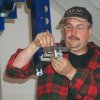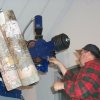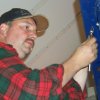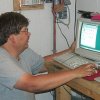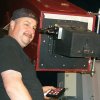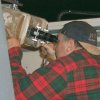

A Tale of a Counterweight
by John F. Martin, July 2000
Not many people realize the Porter Turret Telescope had in the original design provisions space for a second telescope. You see Russell Porter never wanted to waste anything. So to him, the idea of mounting a large bar of iron to counterbalance the 200lb telescope arm was a waste. For whatever reason Porter's original idea never was carried out. There are pictures of the proposed Cassegrain system in the first book of Amateur Telescope Making.
Moving along 60 years, the Springfield Telescope Makers were again in the major project mode. The original design discussions lasted for years. All manner of instrument and mounts were brought up and dismissed while looking for the ideal telescope. As you know, here at Stellafane we almost never tackle anything the easy way.
We looked at fork mounts, catadioptric instruments, radio telescopes, everything but a Newtonian (well only quickly). We finally were swayed by long term club member Jim Daily to build a Schupmann design. Its unique construction was the best match for our site.
Back to our original problem. What to mount it on. Much discussion followed on the merits of Alt/Az vs. Equatorial. After considerable deliberation Alt/Az was picked. The main flaw of this system was the large counterweight to balance the telescope. Somehow a 500 pound block of concrete did not have any self redeeming optical qualities (we could of course made it out of Borosilicate but fine grinding a cube had its own set of difficulties). With a flash of inspiration this flaw was turned into a asset.
Original thought was to mount some kind of light bucket in the counterweight position. A 26" f/5 instrument would be an exact match for the 13" f/10 Schupmann. The club had been working on a 27" blank for an indeterminate period, that seemed to be a fine match. Then one night while acquiring the first star. It struck me. Why not make the side opposite the Schupmann a giant Binocular mount. That would allow an observer a high power, narrow field instrument or low power wide field. Hummmmm now how to do that?
Rummaging through the clubs Junk box (that's the club member's collection of assorted optical stuff) it was found that Jeff Lowe and I each had a 7" f/5 doublet that had originally been used in an optical comparator. These Lenses were designed to form the light path into a parallel group of light beams. The idea was to place the profile of something in this light and the shadow that was formed could be very accurately measured. Obviously these lenses were not of the diffraction limited, astronomical quality our homemade optics strive for, but they met two of the prime requirements for this project. They were FREE and they were HEAVY.
Once the weather got cold enough, work progressed. There are two reasons cold is important to this project. When the weather gets below zero in Vermont its too cold to work at Stellafane. That frees up lots of time. The other is that it is a lot easier to work fiberglass. For those of you that have not worked with fiberglass, it is a must try. It is one of the most versatile telescope making materials I have come across. However, it has one big problem. The warmer it is, the faster the Resin sets up. When the temperature is 70 degrees it sets up in 10 minutes. This is where cold can be used to good advantage. When the temperature is below 30 degrees enough time can be had to form the complex shapes of a project like these binox. Once the fiberglass is in place a heat lamp will quickly set up the project. The only small problem is that the human fingers don't work all that well at 30 degrees.
While working through the original design a couple of things became quickly apparent. One is that the inter-ocular distance for the binox would make the focuser difficult to fabricate. Standard 1 1/4" eyepieces must just about touch to pull this off. It took some creative work to get the light path to do this. I finally settled on diagonal mirrors to do this, as an erect image was not necessary. The other problem was the collimation. There are many different degrees of freedom of many different optical elements. This is not a beginners project.
At this juncture the Counterweight Binocular is mounted. Collimation is under way. Who knows? With a year or two of work maybe we can get the system down to pointing at only two objects, or just maybe only one.
John F. Martin
Member, Springfield Telescope Makers
The 7-inch fiberglass tube binoculars on a tripod being collimated:
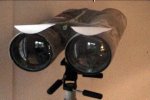
|
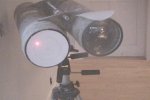
|
John Martin and Jeff Lowe install the 7-inch binoculars as a counterweight on the Schupmann (from the eyepiece end, the Schupmann tube is attached to the altitude axis to the left of the pier, and the binoculars are to the right of the pier).
Back to the McGregor-Schupmann Page
